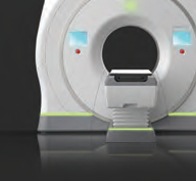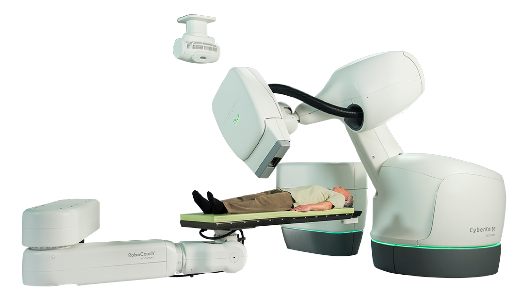Studies presented at the 56th Annual American Society for Radiation Oncology (ASTRO) Meeting in San Francisco from September 14 to 17 reinforce broad-based healthcare professional support of the clinical and quality of life benefits Sunnyvale California-based Accuray Incorporated’s CyberKnife and TomoTherapy radiation oncology systems deliver. A variety of indications including breast, prostate, lung, brain, and head and neck cancers were featured at the meeting, further positioning Accuray as a leader in precise, innovative tumor treatments.
ASTRO 2014 TomoTherapy clinical presentations focused on treatment of breast, brain, and head and neck cancers, and demonstrated the system’s versatility, efficiency and effectiveness as a treatment for routine or more complex cases. Further information on this system is available here.
Accuray cites a notable study [i] (see abstracts in Notes below) that highlighted results from an interim report of an ongoing IRB-approved phase 2 study on accelerated partial breast irradiation (APBI). With a median follow-up of 24 months, data support the use of TomoTherapy for APBI based on its ability to provide patients with decreased mean radiation dose to the heart (0.6 Gy) while providing meaningful local tumor control.
A study [ii] on the use of helical radiation therapy to deliver a simultaneous integrated boost (SIB) during breast cancer treatment concluded, “Helical TomoTherapy is capable of delivering homogeneous treatment plans to the whole breast and lumpectomy cavity using SIB with acceptable acute toxicity.” At three and six month follow-up, the report says patients had minimal residual erythema with all patients either having grade 0 or grade I symptoms, and there were no grade 2 or grade 3 toxicities reported at any endpoint.
A third study [iii] showed a four-fraction stereotactic radiosurgery (SRS) protocol using TomoHelical delivery mode provided excellent tumor control of brain metastases with minimal toxicity, even in patients with multiple tumors or those with large gross tumor volumes.
[adrotate group=”3″]
An additional study [iv] showcased results of a Pareto optimality algorithm developed to identify optimal plans across 40 head and neck cases with lower-neck tumors; each case was randomly assigned and planned with the TomoTherapy System, conventional fixed gantry IMRT, and RapidArc. The study found that more than half of the Pareto optimal plans were generated for the TomoTherapy System, with conventional delivery systems dividing the rest, reinforcing the precise, efficient treatment planning capabilities of the TomoTherapy System.
ASTRO 2014 CyberKnife presentations focused on a range of indications including lung, brain and prostate cancer, and highlighted the benefits of a system that automatically tracks the tumor and adjusts the beam, maximizing the dose delivered to the tumor and minimizing side effects. Further information on this system is available here.
One [v] study of patients with stage 1 non-small-cell lung cancer found that even those with comorbidities, such as chronic obstructive pulmonary disease, experienced excellent rates of disease control including regional failure free survival, distant metastasis free survival and overall survival, with very little toxicity.
Another study [vi] evaluated fractionated stereotactic radiosurgery (F-SRS) versus single-fraction radiosurgery (S-SRS) for the treatment of brain metastases. Use of F-SRS resulted in similar local tumor control and safety profile despite a patient population consisting of larger tumors and worse prognostic factors, indicating that treatment with F-SRS may enable clinicians to expand their patient population.
Several presentations of CyberKnife SBRT continue to validate this precise, innovative approach to the treatment of prostate cancer. Two retrospective analyses [vii] reinforce the use of CyberKnife for the treatment of prostate cancer. One study found patients with low to intermediate-risk prostate cancer experienced a high rate of biochemical progression free survival with acceptable toxicity and PSA levels that often continued to decline beyond two years post-treatment. Another showed use of SBRT as salvage therapy following the recurrence of prostate cancer provides similar efficacy and toxicity to low and high dose rate interstitial brachytherapy, with the significant advantage of being a non-invasive treatment.
Abstracts can also be found on the website of the International Journal of Radiation Oncology Biology Physics.

“We’re excited to see data show the TomoTherapy System provides significant clinical benefits for breast cancer patients and long-term data continue to support the use of the CyberKnife System as a treatment for prostate cancer,” says Joshua H. Levine, president and chief executive officer of Accuray. “In addition, we’re encouraged by customer feedback on the new platforms indicating these systems can increase throughput and broaden clinical utility, enabling more patients to receive precisely targeted radiation treatments.”
Cyberknife And Tomotherapy Systems
 The Accuray CyberKnife M6 Series and TomoTherapy H Series treatment solutions cover the entire spectrum of radiation therapy needs. The CyberKnife M6 Series enables precise, high-quality, dose distributions to be confidently delivered to the patient with extreme accuracy over a minimum number of treatments, reducing side effects and preserving patients’ quality of life.
The Accuray CyberKnife M6 Series and TomoTherapy H Series treatment solutions cover the entire spectrum of radiation therapy needs. The CyberKnife M6 Series enables precise, high-quality, dose distributions to be confidently delivered to the patient with extreme accuracy over a minimum number of treatments, reducing side effects and preserving patients’ quality of life.
The CyberKnife System is the only robotic full-body radiosurgery system available today. The TomoTherapy H Series efficiently enables physicians to customize treatment plans for the entire range of radiation therapy patients and disease types. Its innovative design enables treatment plans to be delivered with integrated, daily CT image guidance, enhancing accuracy and delivering highly precise, intensity-modulated radiation for optimal sparing of healthy tissue and critical structures.
CyberKnife M6 Series
The CyberKnife System, the premier solution for full-body robotic radiosurgery, now extends its accuracy and precision to radiation therapy allowing you the freedom to choose the very best treatment for each of your patients, with confidence and without compromise.
The CyberKnife M6 Series has the capabilities and efficiency required for every radiation oncology practice for the treatments accepted today, as well as setting a foundation for those of tomorrow. It is the only truly robotic system in the market, developed to meet the evolving needs of the most demanding radiation oncology programs.
Benefits of the CyberKnife M6 Series:
 With the new InCise Multileaf Collimator (optional on the FI version), Accuray says the CyberKnife M6 Series is the only clinical solution to combine the benefits of the Multileaf Collimator (MLC) beam shaping with continual image guidance and non-isocentric, non-coplanar treatment delivery. Precisely sculpting dose to spare healthy tissue while maintaining sub-millimeter accuracy — even for targets that move during respiration — the CyberKnife M6 Series is the clinical solution you require when accuracy, flexibility, and efficiency are essential.
With the new InCise Multileaf Collimator (optional on the FI version), Accuray says the CyberKnife M6 Series is the only clinical solution to combine the benefits of the Multileaf Collimator (MLC) beam shaping with continual image guidance and non-isocentric, non-coplanar treatment delivery. Precisely sculpting dose to spare healthy tissue while maintaining sub-millimeter accuracy — even for targets that move during respiration — the CyberKnife M6 Series is the clinical solution you require when accuracy, flexibility, and efficiency are essential.
Created to make personalized treatments an option for patients, Accuray says the CyberKnife M6 Series offers a comprehensive set of clinical features. Indication-specific tumor tracking with automatic correction throughout treatment, true robotic mobility, and advanced collimation integrate seamlessly into the only system to automatically stay on target despite patient and tumor motion. It enables you to treat tumors anywhere in the body with confidence and without compromise.
 Designed with the patient in mind, the CyberKnife M6 Series enhances patient comfort and improves the patient experience in a number of ways:
Designed with the patient in mind, the CyberKnife M6 Series enhances patient comfort and improves the patient experience in a number of ways:
• Soothing environmental elements
• Easy and efficient treatment
• Frameless and non-invasive
• Uniquely personalized treatments
Accuray says the CyberKnife M6 Series introduces clinical capabilities not possible with other treatment systems. With the flexibility of the InCise Multileaf Collimator and robotic delivery, tumors previously thought untreatable with radiosurgery and SBRT can now be treated efficiently and with unrivaled accuracy and tissue sparing. Clinicians have the freedom to choose the very best treatment for each of their patients, expanding the field of radiosurgery with new possibilities.
The CyberKnife M6 Series is available in three configurations:
The CyberKnife M6 FIM System – full body robotic radiosurgery and radiation therapy
ul
- Advanced system geometry
- Enhanced design
- Fixed collimators
- Iris Variable Aperture Collimator
- InCise Multileaf Collimator
- CNS clinical package
- Prostate clinical package
- Lung and prone clinical package
- Clinical efficiency package
The CyberKnife M6 FM System – Advanced full-body robotic radiosurgery with added flexibility and efficiency
- Advanced system geometry
- Enhanced design
- Fixed collimators
- InCise Multileaf Collimator
- CNS clinical package
The CyberKnife M6 FI System – solution for full-body robotic radiosurgery
- Advanced system geometry
- Enhanced design
- Fixed collimators
- Iris Variable Aperture Collimator
For more information, visit:
http://www.accuray.com
Notes
Abstracts:
[i] de Paula, U. et al., Full Local Control With Accelerated Partial Breast Irradiation (APBI) by Tomotherapy After Breast-Conservative Surgery for Patients Suitable, or Not, According to ASTR0-2009 Consensus Statement: Interim Report After 2 Years Follow-Up. 56th Annual American Society for Radiation Oncology (ASTRO) Meeting, San Francisco, California, September 14 17, 2014.
[ii] Wojcieszynski, A. et al., Toxicity From Breast Cancer Treatment Using Helical Intensity Modulated Radiation Therapy With an Incorporated Boost. 56th Annual American Society for Radiation Oncology (ASTRO) Meeting, San Francisco, California, September 14 17, 2014.
[iii] Nagai, A. et al., Hypofractionated Stereotactic Radiation Therapy Using Helical Tomotherapy for Single or Multiple Brain Metastases. 56th Annual American Society for Radiation Oncology (ASTRO) Meeting, San Francisco, California, September 14 17, 2014.
[iv] Ruan, D. et al., A Pareto Optimality Test Scheme and its Utilization to Assess Systematic Variation of Plan Quality Across Treatment Modalities. 56th Annual American Society for Radiation Oncology (ASTRO) Meeting, San Francisco, California, September 14 17, 2014.
[v] Samuelian, J.M., Curative Treatment of Stage I Non-Small Cell Lung Cancer Using Robotic Stereotactic Radiation in Patients With COPD: A VA Population Study. 56th Annual American Society for Radiation Oncology (ASTRO) Meeting, San Francisco, California, September 14 17, 2014.
[vi] Savir, G. et al., Comparison of Fractionated Stereotactic Radiosurgery and Single Fraction Stereotactic Radiosurgery for the Treatment of Brain Metastases. 56th Annual American Society for Radiation Oncology (ASTRO) Meeting, San Francisco, California, September 14 17, 2014.
[vii] Lloyd, S. et al., Robotic Stereotactic Body Radiation Therapy for Prostate Adenocarcinoma. 56th Annual American Society for Radiation Oncology (ASTRO) Meeting, San Francisco, California, September 14 17, 2014. Fuller, D.B. et al., HDR-Like SBRT for Post-Radiation Therapy Locally Recurrent Prostatic Carcinoma: PSA Response, DFS, and Toxicity Assessment. 56th Annual American Society for Radiation Oncology (ASTRO) Meeting, San Francisco, California, September 14 17, 2014.
Sources:
Accuray Incorporated
56th Annual American Society for Radiation Oncology (ASTRO) Meeting
Image Credits:
Accuray Incorporated



